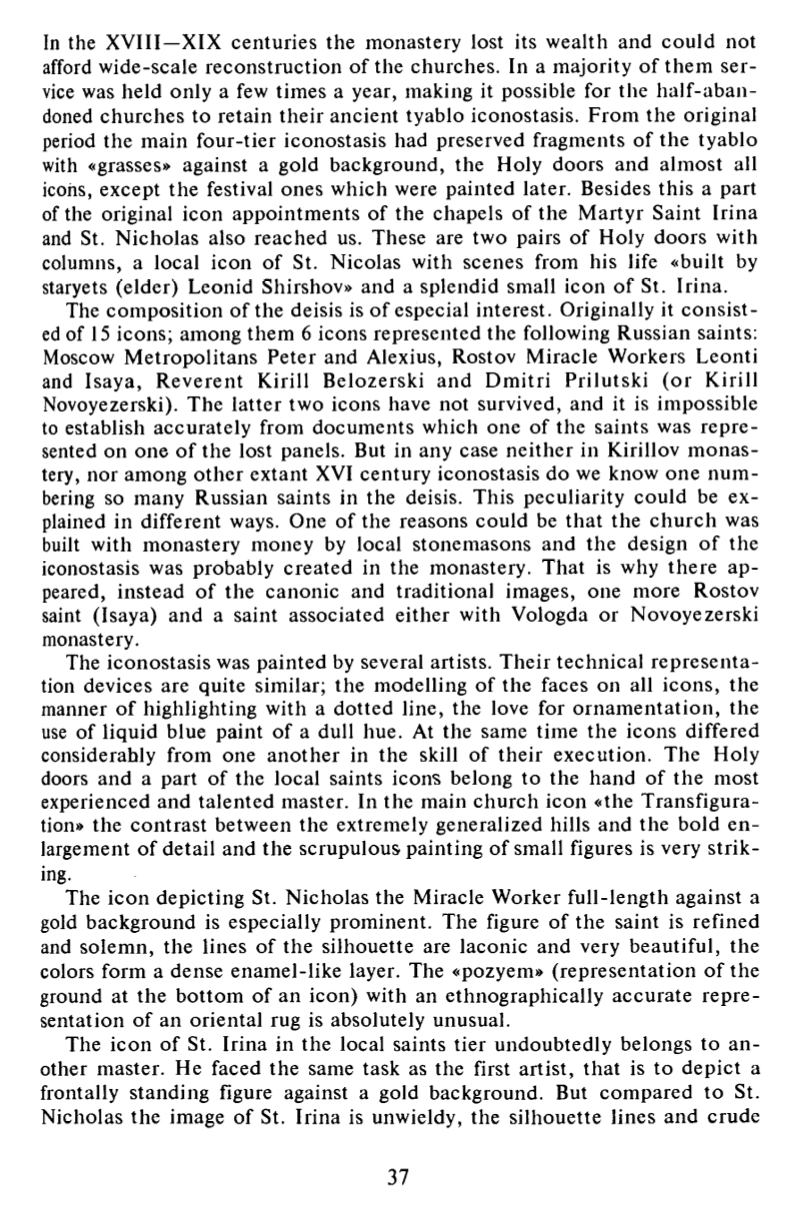

In the XVIII—XIX centuries the monastery lost its wealth and cou ld not
afford wide-scale reconstruction of the churches. In a majority o f them se r
vice was held only a few times a year, making it possible for the ha lf-aban-
doned churches to retain their ancient tyablo iconostasis. From the original
period the main four-tier iconostasis had preserved fragments of the tyablo
with «grasses» against a gold background, the Holy doors and almost all
icons, except the festival ones which were painted later. Besides this a part
of the original icon appointments of the chapels of the Martyr Saint Irina
and St. Nicholas also reached us. These are two pairs of Holy doors with
columns, a local icon of St. Nicolas with scenes from his life «built by
staryets (elder) Leonid Shirshov» and a splendid small icon o f St. Irina.
The composition of the deisis is o f especial interest. Originally it con s is t
ed of 15 icons; among them 6 icons represented the following Russian saints:
Moscow Metropolitans Peter and Alexius, Rostov Miracle Workers Leonti
and Isaya, Reve ren t Kirill Belozerski and Dm itri Prilu tsk i (o r Kirill
Novoyezerski). The latter two icons have not survived, and it is impossible
to establish accurately from documents which one of the saints was rep re
sented on one o f the lost panels. But in any case neither in Kirillov mon a s
tery, nor among o ther extant XVI century iconostasis do we know one num
bering so many Russian saints in the deisis. This peculiarity could be ex
plained in different ways. One of the reasons could be that the chu rch was
built with monastery money by local stonemasons and the design o f the
iconostasis was probably created in the monastery. That is why there a p
peared, instead o f the canonic and traditional images, one more Rostov
saint (Isaya) and a saint associated either with Vologda or Novoyezerski
monastery.
The iconostasis was painted by several artists. Their technical rep re sen ta
tion devices are quite similar; the modelling of the faces on all icons, the
manner o f highlighting with a dotted line, the love for o rnamen ta tion , the
use of liquid blue paint of a dull hue. At the same time the icons differed
considerably from one ano ther in the skill of their execution. The Holy
doors and a part of the local saints icons belong to the hand of the most
experienced and talented master. In the main church icon «the Transfigura
tion» the contrast between the extremely generalized hills and the bold e n
largement of detail and the scrupulous painting of small figures is very strik
ing.
The icon depicting St. Nicholas the Miracle Worker full-length against a
gold background is especially prominent. The figure of the saint is refined
and solemn, the lines of the silhouette are laconic and very beautiful, the
colors form a dense enamel-like layer. The «pozyem» (representation o f the
ground at the bo ttom of an icon) with an ethnographically accurate rep re
sentation of an oriental rug is absolutely unusual.
The icon of St. Irina in the local saints tier undoubtedly belongs to a n
other master. He faced the same task as the first artist, that is to depict a
frontally standing figure against a gold background. But compared to St.
Nicholas the image of St. Irina is unwieldy, the silhouette lines and crude
37















